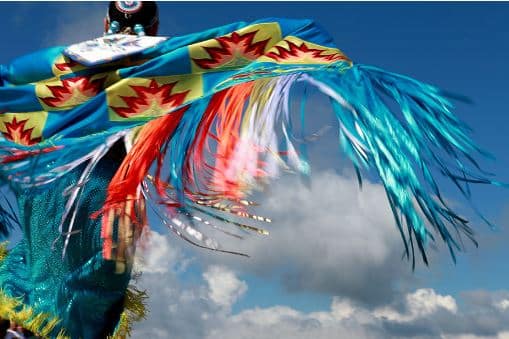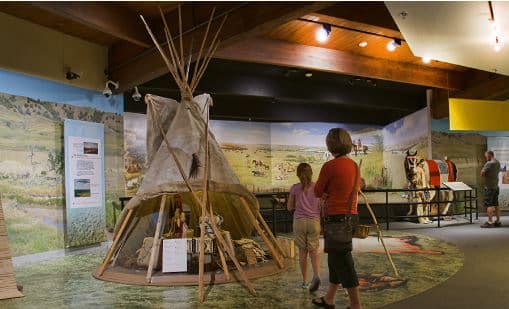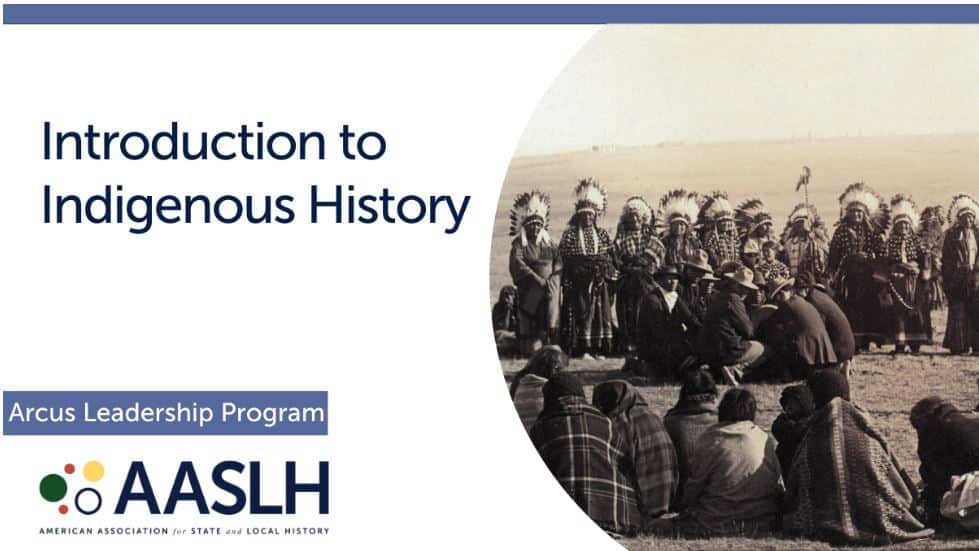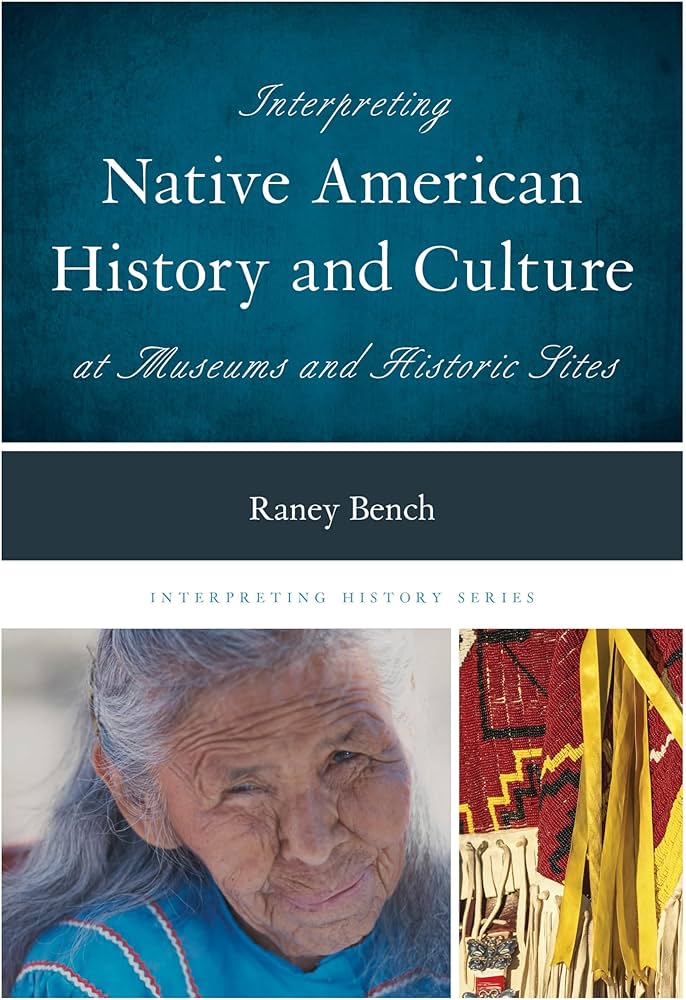
By Megan Spainhour, AASLH Membership and Office Coordinator
Monday, October 14th is celebrated as Indigenous People’s Day, and so today we also honor the numerous indigenous museums around the country, many of them AASLH members.
In 1977, a discussion began among the members of The International Conference on Discrimination Against Indigenous Populations in the Americas to replace Columbus Day with a celebration to be known as Indigenous Peoples Day. In 1992, Indigenous Peoples Day was instituted in Berkeley, California to coincide with the 500th anniversary of the arrival of Columbus in the Americas on October 12, 1492. By 2014, several other states began adopting the holiday, and by 2021, President Biden formally commemorated the holiday with a presidential proclamation, stating that “Since time immemorial, American Indians, Alaska Natives, and Native Hawaiians have built vibrant and diverse cultures — safeguarding land, language, spirit, knowledge, and tradition across the generations. On Indigenous Peoples’ Day, our Nation celebrates the invaluable contributions and resilience of Indigenous peoples, recognizes their inherent sovereignty, and commits to honoring the Federal Government’s trust and treaty obligations to Tribal Nations…The contributions that Indigenous peoples have made throughout history — in public service, entrepreneurship, scholarship, the arts, and countless other fields — are integral to our Nation, our culture, and our society.”
A wonderful way to celebrate and honor Indigenous Peoples’ Day is to visit a museum, historical organization or even a local pow-wow in your area. Visiting these locations not only support the tribal nation in that area, but also help us to learn about the indigenous culture, rights and history.
Two institutional members of AASLH are the Aktá Lakota Museum & Cultural Center, an outreach of the St. Joseph’s Indian School in South Dakota, and The Plains Indians and Pioneers Museum of Oklahoma. Other supporting member museums and organizations of note include the Federated Indians of Graton Rancheria in California, Pamunkey Indian Museum in Virginia, Stewart Indian School in Nevada, Genoa US Indian School in Nebraska, The Institute for American Indian Studies in Connecticut, Heard Museum in Arizona and Eiteljorg Museum in Indiana, among others.
 Exhibit Space at the Plains Indians and Pioneers Museum
Exhibit Space at the Plains Indians and Pioneers Museum
I spoke with Director of The Plains Indians and Pioneers Museum, Mikel Robinson, about what she wished people knew about the museum. “Nestled less than 20 miles away from the Plains Indians and Pioneers Museum in Woodward, Oklahoma, lies the Historic Fort Supply site, a symbol of both tragedy and resilience. While It is primarily known for being the launching point of Major General Philip Sheridan’s infamous attacks on Plains Tribes in 1868-1869, there is another side that often goes unnoticed in the pages of history. This “Winter Campaign,” as it came to be known, resulted in the massacre and utter decimation of Peace Chief Black Kettle’s village along the Washita River by Lt. Col. George Armstrong Custer. And though this heinous act may overshadow its legacy, it is important to remember that the mission of the U.S. Army assigned to Fort Supply changed by the mid-1870s. They took on the crucial role of maintaining peace and protecting the tribes living in the region from unscrupulous whites from neighboring Kansas, who sought to steal horses and trade illegal goods such as liquor and guns with remaining tribal members. The fort stands as a testament to both the darker moments of our nation’s past and the efforts towards reconciliation and understanding that followed.”
LaRayne Woster, who fills the role of Native American Studies Teacher and Cultural Specialist at St. Joseph’s Indian School, and is a member of the Lakota tribe, explained that the most impactful history in the Native American story is that “the land that was our place to live from the beginning of time, the sacred Black Hills of South Dakota, was given to use in a treaty made by our government. Everything is tied to the land and our way of life. This is a walk of life, not just something you choose to do. It is in our blood and DNA. When you learn about why something has been done a certain way for thousands of years, it all makes sense. Such as gender roles, prayer, honoring animals and nature, our language and the deep meaning behind the words. It is a powerful, strong culture.” I also asked Woster what her favorite piece or artifact is at the Aktá Lakota Museum & Cultural Center and why. She responded that “The diorama is my favorite exhibit area because it shows a lot of gender roles, work, the land, the prayer, the thankfulness/gratefulness, many Lakota values and spiritual elements as well.” If you want to learn more about LaRayne Woster growing up as a part of the Lakota Tribe, check out her book Brave Girl: A Story on the Wind, by Scott Woster.
 Exhibit Space at the Aktá Lakota Museum and Cultural Center
Exhibit Space at the Aktá Lakota Museum and Cultural Center
I also connected with Aktá Lakota Museum & Cultural Center Director Dixie Thompson. When asking Dixie what she believes is the most impactful history in the Native American story, she replied, “I have a deep appreciation for our Children’s Exhibits: Childhood on the Plains as they detail that children stood at the center of the Plains family life. Children were considered ‘sacred’ (wakáŋ) as they were the future of the people. In addition to parents, members of the extended family “tiyóšpaye” served as role models and viewed children as common responsibility. There was and still is a close relationship between Plains Indian children and their grandparents. Grandparents reinforced the obligations of kinship and taught the tasks of camp life from Growing up Female to Becoming a Woman; to Growing up Male and Becoming a Man.”
A huge thank you to Dixie Thompson, Mikel Robinson, Wanda Bunker and LaRayne Woster who assisted me in my curiosity and thirst for knowledge of our Native American museums. Be sure to support your local indigenous tribes by visiting their museums, respectfully exploring their culture and supporting their businesses. Also be sure to check out AASLH’s widely popular course offered below, as well as a few of my favorite books on Indigenous History.
 Recommended AASLH Course: Arcus Course: Introduction to Indigenous History, taught by Heather Bruegl, a citizen of the Oneida Nation of Wisconsin.
Recommended AASLH Course: Arcus Course: Introduction to Indigenous History, taught by Heather Bruegl, a citizen of the Oneida Nation of Wisconsin.
Are you a history or museum professional who is interested in learning Indigenous history, but hasn’t taken the time to do it yet? In this course you will be given a basic introduction to Indigenous history from a basic vocabulary to contemporary issues today. This is a self-paced course and can be taken at any time.
COST: $65 AASLH Members / $90 Nonmembers
Indigenous History Reading Recommendations:
- “All the Real Indians Died Off” and 20 Other Myths About Native Americans by Roxanne Dunbar-Ortiz
- An Indigenous Peoples’ History of The United States by Roxanne Dunbar-Ortiz
- Red Dirt: Growing Up Okie by Rozanne Dunbar-Ortiz
- Republic of Indians: Empires of Indigenous Law in the Early American South by Bradley J. Dixon
- The Rediscovery of America: Native Peoples and the Unmaking of U.S. History by Ned Blackhawk
- The Lost Journals of Sacajewea by Debra Magpie Earling
- Fierce Climate, Sacred Ground: An Ethnography of Climate Change in Shishmaref, Alaska by Elizabeth Marino
- Indigenous Memory, Urban Reality by Michelle R. Jacobs
- Interpreting Native American History and Culture at Museums and Historic Sites by Raney Bench (AASLH members can use their code to save 20% at Rowman & Littlefield)
- Interpreting Difficult History at Museums and Historic Sites by Julia Rose (AASLH Members use their code to save 20% at Rowman & Littlefield)



